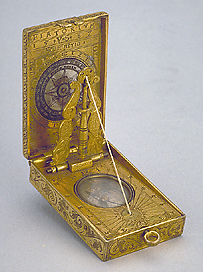
Inclining Dial
Signed by Ulrich Schniep
Dated 1587; Munich
Brass; 55 x 37 x 14 mm closed
The outer surface of the lid is inscribed with the names and latitudes of 31 European cities and labelled 'Tabula latitudinis Regionum': 'Augusta 48', 'Antverpia 51', 'Ancona 44', 'Argentina 49', 'Brunschwg 53', 'Bononia 45', 'Colonia 51', 'Cracouia 50', 'Francoford 50', 'Ferraria 43', 'Florentia 43', 'Genua 42', 'Gretza 47', 'Haydelberg 50', 'Hamiburg 54', 'Inspruch 47', 'Lundinum 52', 'Mediolan 45', 'Marsilia 43', 'Monachium 48', 'Nomberga 49', 'Neapolis 41', 'Portugalla 42', 'Parisius 48', 'Praga 50', 'Sauonia 43', 'Toletum 40', 'Tibingna 43', 'Veneiae 45', 'Vienna 48', 'Vitemberg 52'.The inner surface of the lid has a volvelle for converting common hours into Italian hours. It consists of an outer, fixed ring, marked twice clockwise 1 to 12 and divided to 20 minutes, and a central silvered disc marked 1 to 24 and divided to 20 minutes. An inner circle is labelled 'HABETVR HORA ITALIC SI XXIIII PONAS SVPER HORAM OCCASVS'. The four cardinal directions are marked in Latin outside the volvelle. Above 'Septentrio' is the inscription 'FIATORIUM' and the date and initials of the maker '15 VS 87'. The box contains a string gnomon dial with a folding plummet and an inset compass. The compass is fixed to the floor of the box. The dial plate is pivoted to the edges of the box so that it can be tilted and is therefore adaptable to a range of latitudes 42? to 52? as marked on the base of the plummet. The hour lines which radiate from a sun effigy are marked 4 to 12 to 8 and divided to 1/2 hours. The plummet holder is engraved with a pair of dragon's heads or sea monsters. The silvered compass, mounted on a silvered disc, can be rotated to suit declinations from 0? to 30? in both directions from true north. The disc is marked 'GRADUS DECLINAIO MAGNETIS'. The degree scale is marked 30 to 0 to 60, numbered by 10 and divided to 2. The outer surface and the edges of the box are decorated with strapwork and scrollwork. The instrument was presented by J. B. Heath in 1844 and is described in F. A. B. Ward, A Catalogue of European Scientific Instruments in the Department of Medieval and Later Antiquities of the British Museum (London, 1981), p. 43, no. 105. Silke Ackermann
British Museum, London
Registration no. MLA 1844, 7-30.1
© British Museum, London. All rights reserved. Information and images provided here may not be reproduced in any form or by any means without the prior written permission of the museum.
Basic URL: http://www.mhs.ox.ac.uk/epact/catalogue.php?ENumber=31122 |


